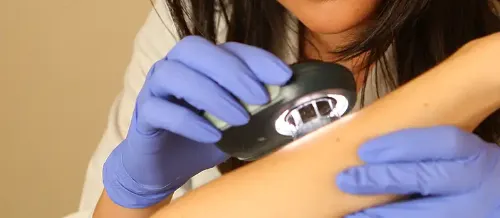Seborrheic dermatitis
"The patient should know that he will need maintenance treatment, since the disease persists from months to years, sometimes evolving into outbreaks".
DR. NURIA RODRÍGUEZ
SPECIALIST. DERMATOLOGY DEPARTMENT

Seborrheic dermatitis is a type of endogenous eczema, that is, not triggered by external agents.
The most frequent locations of the seborrheic dermatitis are those where a greater number of sebaceous glands exist as it is the scalp, midfacial region, to the sides of the nose, behind the ears, in the eyebrows, mediothoracic region, interscapular and perigluteal.
It can affect both adults and infants, generally arising in those periods of life where there is greater sebaceous activity resulting from a hormonal stimulus.

What are the symptoms of seborrheic dermatitis?
The scalp is almost always affected, with small scales that fall constantly or scales agglutinated by sebaceous secretion that are difficult to remove.
Sometimes, it is possible to appreciate an erythematous area in the area of implantation of the scalp ("seborrheic crown"). With certain frequency, it is observed a desquamation in eyebrows, eyelashes, beard hair and moustache, as well as a reddening and desquamation of the interciliary region, the nasogenian furrow and the retroauricular region.
In some patients, the eyelids become inflamed and small scabs form on the parpebral edge that agglutinate the eyelashes.
At the level of the trunk, seborrheic dermatitis usually manifests itself as rounded erythematous plaques with an erythematous border, slightly pruritic, located in the middle region of the trunk (preesternal and interscapular). Sometimes these plaques are more erythematous and are covered by very adherent scales, simulating psoriasis lesions.
The most common symptoms are:
- Scales on the skin.
- Itching.
- Slight redness.
Do you have any of these symptoms?
You may have a seborrheic dermatitis
What are the causes of seborrheic dermatitis?
The exact cause is unknown, involving mainly two factors: seborrheic skin and microbial involvement.
The androgenic influence on sebaceous secretion explains the appearance of ezcematodes in the infant, influenced by maternal hormones, and in the onset of puberty. In situations of fatigue and increased stress, there may be an increased secretion of androgens by the adrenal glands in response to increased secretion of ACTH from the pituitary gland.
The most frequent infectious agent involved in the development of seborrheic dermatitis is Pitirosporum ovale.
What is your prognosis?
The response to treatment is very good, but it is necessary for the patient to know that he or she will need maintenance treatment since the disease persists from months to years, sometimes evolving into outbreaks, improving in the warmer seasons and worsening in the cold months and in situations of fatigue and emotional stress.
How is seborrheic dermatitis diagnosed?

The diagnosis is based on the clinic, by the appearance and location of the skin lesions.
On physical examination, patches with greasy scales on the scalp and erythematous scaly lesions located in the insertion area such as scalp, retroauricular folds, nasolabial folds or eyebrows are characteristic. In babies, the characteristic lesion is "cradle cap".
The differential diagnosis of seborrheic dermatitis should be made with other desquamative dermatitis such as atopic dermatitis, candidiasis, dermatophytosis, psoriasis, rosacea, systemic lupus erythematosus and ringworm.
How is seborrheic dermatitis treated?
There are a number of general hygiene measures, such as avoiding very hot showers, centrally heated or air-conditioned environments, or situations of increased emotional stress or fatigue. For daily hygiene, neutral moisturizing soaps and non-greasy moisturizing creams and/or lotions should be used.
The local treatment varies according to the affection.
For scalp forms, mild sulfonated shampoos with cyclopiroxolamine are indicated, with or without 2% salicylic acid. Shampoos with 1% ketoconazole are sometimes useful.
For facial region lesions, 1% ketoconazole creams or solutions with lithium succinate.
Low-potency glucocorticoids, used only in the first few days, are useful. Newer calcineurin inhibitors may also be useful in moderation.
In more severe cases, systemic treatments such as tetracyclines that decrease sebaceous secretion can be used.
Where do we treat it?
IN NAVARRE AND MADRID
The Department of Dermatology
of the Clínica Universidad de Navarra
The Department of Dermatology of the Clinica Universidad de Navarra has extensive experience in the diagnosis and treatment of dermatological diseases.
We have extensive experience in highly precise surgical treatments, such as Mohs surgery. This procedure requires highly specialized personnel.
We have the latest technology for the dermo-aesthetic treatment of skin lesions, with the aim of achieving the best results for our patients.
Diseases we treat

Why at the Clinica?
- Experts in Mohs Surgery for the treatment of skin cancer.
- We have the best technology for dermo-aesthetic treatments.
- Safety and quality assurance of the best private hospital in Spain.








